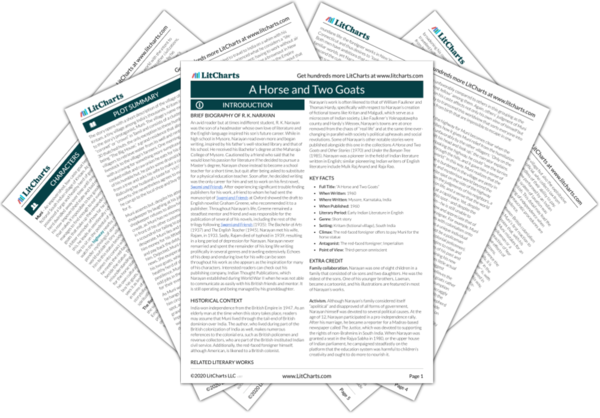Perspective
In R. K. Narayan’s story, the main character, Muni, craves the stimulation and freedom he can experience near the highway, where he sits at the foot of a clay statue and watches his goats graze. This stands in contrast to the stifling atmosphere of the village, where everyone knows everyone else’s business and most people seem to have a long memory for Muni’s misdeeds—alleged and actual. Somewhat similarly, the “Red-Faced Foreigner,”…
read analysis of PerspectiveColonialism and Neocolonialism
Echoes of British colonialism in India, which achieved its independence in 1947, are present throughout the story. The presence of neocolonialism is keenly felt through the appearance of the “Red-Faced Foreigner,” pointing to the ways in which the U.S., replacing Britain as the dominant world superpower, has made inroads in India economically and culturally through tourism. The similarities between the two types of colonialism—old and new—are not difficult to fathom, as India (at…
read analysis of Colonialism and NeocolonialismMaterialism vs. Spirituality
Both Muni and the Red-Faced Foreigner struggle with preoccupations over possessing material objects. The foreigner struggles more with materialism as he is more prosperous and thus has more possessions than Muni, but this preoccupation figures, albeit to a lesser extent, in Muni’s life as well. Unlike the foreigner, however, Muni revels in recounting his past and in discussing his spirituality in the form of mythological tales, which is shown to be at odds with the…
read analysis of Materialism vs. Spirituality
Linear vs. Cyclical Time
Narayan employs two competing conceptions of time in the story—linear and cyclical—roughly corresponding to the characters Muni and the foreigner. Whereas Muni has a shaky grasp of linear time, being unable to recall even his own age, the foreigner seems fixated on marking and saving time, which he views as a scant and valuable resource. Muni, with his more cyclical conception of time, does not seem perturbed when he spends time doing something that…
read analysis of Linear vs. Cyclical TimeRelations Between Men and Women
Although women do not figure prominently in Narayan’s story, Muni’s relationship with his wife is the central pivot around which the author explores the issue of relationships between men and women. Although women in the story are clearly subordinate to men and men often engage in misogynistic commentary regarding the women in their lives, Narayan gives readers a subtle sense that, despite all this, women have more authority than is apparent at first glance…
read analysis of Relations Between Men and Women






